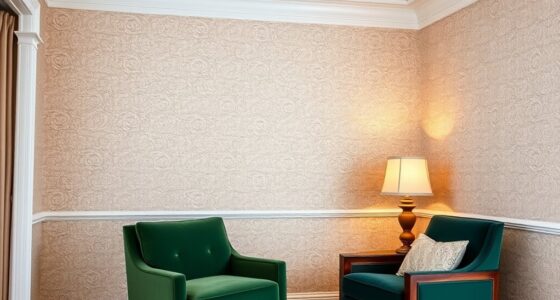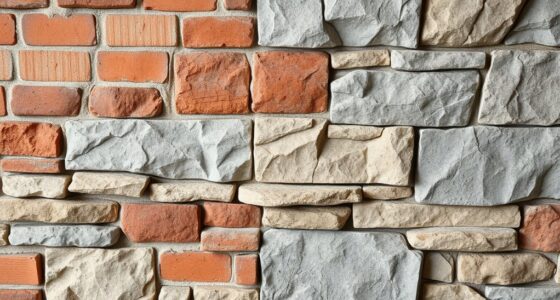To plan effective triptychs and diptychs, start by choosing a clear theme or narrative that guides your panels. Consider how to use symbolism, color, and composition to create a cohesive flow across the pieces. Pay attention to layout, spacing, and material choices to make certain visual unity. Focus on highlighting focal points and maintaining consistent style and textures. Continue exploring these strategies to craft a compelling, harmonious multi-panel artwork that captures viewers’ interest.
Key Takeaways
- Define a clear core message and narrative to ensure panels work cohesively and tell a compelling story.
- Use symbolism, color symbolism, and thematic elements to create visual connections and enhance storytelling across panels.
- Plan panel sequence and visual flow with techniques like perspective, leading lines, and balanced composition.
- Maintain consistency in materials, textures, and color palettes to unify the multi-panel artwork.
- Consider framing, spacing, and focal points to optimize viewer engagement and overall visual impact.
Understanding the Significance of Multi-Panel Formats

Have you ever wondered why artists choose to present their work in multiple panels? Throughout history, multi-panel formats like triptychs and diptychs have held deep cultural significance, often used in religious and ceremonial art. The historical context reveals that these formats allowed artists to tell complex stories or depict scenes with layered meaning, engaging viewers in a narrative journey. They also served practical purposes, such as fitting large works into sacred spaces or creating portable altarpieces. Additionally, these formats facilitated the storytelling process, allowing for a segmented yet cohesive visual experience. Culturally, these multi-panel pieces became symbols of spiritual devotion, community identity, or political power. Understanding this background helps you appreciate why artists continue to use these formats today, blending art historical significance with new storytelling approaches to deepen the viewer’s experience and connect with cultural symbolism. A thorough knowledge of art historical context enriches appreciation for the intricate design and purpose behind these multi-panel works.
Selecting a Theme and Narrative Structure

Start by defining your core message so your panels work together to tell a clear story. Then, focus on establishing a visual flow that guides viewers seamlessly from one image to the next. Finally, consider how to sequence your panels for maximum impact, creating a compelling narrative that engages your audience.
Defining Your Core Message
How do you guarantee your triptych or diptych conveys a clear and compelling message? Start by defining a strong core theme that resonates emotionally. Use symbolism intentionally to deepen meaning—every element, shape, or object can symbolize ideas or feelings. Incorporate color symbolism to reinforce your message; bold colors can evoke passion or urgency, while muted tones suggest calm or reflection. Consistent symbolism across panels creates a unified narrative, guiding viewers through your story. Keep your core message focused, and let each panel contribute to it without distraction. By thoughtfully selecting symbols and colors that align with your theme, you ensure your artwork communicates clearly and leaves a lasting impression.
Establishing Visual Flow
What makes your triptych or diptych visually compelling is the way you guide viewers through a clear and engaging narrative. To establish visual flow, select a cohesive theme that connects each panel. Use color harmony to unify the composition, guaranteeing transitions feel seamless. Incorporate perspective techniques like leading lines or varying scales to create depth and direct attention. Consider this structure:
| Element | Application |
|---|---|
| Color Harmony | Use consistent or complementary colors across panels |
| Perspective Techniques | Create depth with converging lines or shifting viewpoints |
| Narrative Flow | Arrange panels to tell a logical, smooth story |
This approach ensures your panels work together, guiding viewers effortlessly from one image to the next. Additionally, visual flow can be enhanced by thoughtful composition and storytelling techniques that engage the viewer throughout the experience. Employing macroscopic perspective and using thematic elements helps in creating a cohesive visual narrative that maintains viewer interest from panel to panel. Furthermore, integrating color harmony principles can strengthen the connection between panels, making the overall piece more harmonious and compelling. Integrating asset division principles such as clear contribution roles can also metaphorically inform how each panel relates to the overall story, ensuring a balanced and harmonious presentation.
Sequencing for Impact
Once you’ve established visual flow within your triptych or diptych, the next step is to shape its overall impact through careful sequencing. You want to craft a narrative that guides viewers smoothly from one panel to the next. Use color harmony to create a cohesive story; consistent or complementary hues can unify the panels and evoke emotion. Framing techniques also play a vital role—consider how each panel’s composition leads the eye naturally to the next, emphasizing key moments or themes. Balance contrast and harmony to build tension or resolution across the series. Thoughtful sequencing ensures your artwork resonates, making the entire piece more engaging and memorable. Focus on how each panel connects, creating a compelling visual rhythm that enhances your intended message. Additionally, understanding how visual storytelling techniques can influence the overall presentation can help you tailor your artwork to specific audiences or settings. Incorporating emotional impact into your sequencing can further deepen viewers’ connection to your narrative, making your art more compelling and memorable.
Planning Composition and Visual Flow

Have you ever wondered how to create a seamless narrative across your triptych or diptych? The key is planning your composition and visual flow carefully. Start with these steps:
- Use color harmony to connect panels, creating a unified look that guides the viewer’s eye smoothly.
- Apply framing techniques to emphasize focal points and direct attention across panels.
- Consider the visual rhythm—balance elements to lead naturally from one panel to the next.
- Think about overlap and spacing to ensure continuity without clutter, maintaining harmony and clarity.
- Incorporate visual storytelling strategies to craft a compelling narrative that engages viewers throughout the panels.
Considering Layout and Panel Arrangement

After establishing a cohesive visual flow, the next step is to thoughtfully consider how to arrange your panels. Focus on achieving balanced panel symmetry to create harmony across the entire piece. Symmetrical layouts can evoke stability and order, while asymmetrical arrangements add dynamism. Pay attention to color harmony, ensuring that the hues across panels complement each other and reinforce the overall mood. Consistent color schemes or deliberate contrasts help unify the composition, guiding the viewer’s eye smoothly from one panel to the next. Think about how the placement of each panel influences the narrative or emotional impact. By carefully planning your layout with attention to symmetry and color harmony, you’ll craft a compelling, cohesive multi-panel artwork. Additionally, considering visual balance and compatibility factors such as emotional tone and thematic resonance can enhance the viewer’s overall experience. Incorporating an understanding of regulatory considerations can also ensure your artwork aligns with institutional standards if displayed publicly or in galleries. Recognizing the importance of traditional techniques alongside modern methods can further refine the overall presentation and authenticity of your work.
Choosing Materials and Mediums for Cohesion

Choosing the right materials and mediums is essential for creating cohesion across your triptych or diptych. Material harmony guarantees that each panel feels connected, while consistent medium usage maintains visual flow. To achieve this, consider these factors: 1. Use the same or compatible materials, like oil or acrylic paints, to assure medium consistency. 2. Select surfaces that complement each other, such as canvas or wood panels, for uniformity. 3. Incorporate similar textures or finishes to reinforce material harmony. 4. Keep your color palette consistent across panels to unify the overall piece. Additionally, maintaining emotional alignment can help ensure your creative energy remains focused and harmonious throughout the process. Recognizing the importance of emotional support can also help sustain motivation and resilience during your artistic journey. Furthermore, understanding how lifestyle choices impact your creative environment can contribute to a more cohesive and inspiring art piece. Paying attention to the material choices involved in your art supplies can further enhance the unity of your work.
Tips for Executing and Assembling Your Artwork

Once you’ve selected your materials and prepared your surfaces, it’s time to focus on executing and assembling your artwork with precision. Pay close attention to panel progressions, guaranteeing they flow seamlessly and create a unified visual narrative. Use consistent brushwork, line work, or texture to maintain cohesion across panels. Color harmony is vital—select a consistent palette and apply colors thoughtfully to tie the panels together. When assembling, double-check alignments and spacing to keep the overall composition balanced. Take your time during the process, making adjustments as needed to guarantee smooth panel progressions and harmonious color relationships. Ensuring visual cohesion through careful planning enhances the impact of your triptych or diptych, making the final piece feel intentional and cohesive. Additionally, understanding the contrast ratio of your materials can help you achieve deeper blacks and brighter highlights, adding depth and dimension to your artwork. Paying attention to focal points within each panel can also strengthen the narrative flow and viewer engagement.
Frequently Asked Questions
How Do I Determine the Optimal Number of Panels for My Artwork?
You determine the ideal number of panels by considering your panel arrangement and how it guides viewer engagement. Think about how many sections tell your story best without overwhelming or underwhelming viewers. Experiment with different setups, keeping balance and flow in mind. Less can be more, so start simple and add panels gradually, ensuring each enhances the overall composition and maintains viewer interest effectively.
What Are Common Challenges Faced When Creating Multi-Panel Art?
Creating multi-panel art can feel like balancing a tightrope walk. Common challenges include maintaining perfect panel alignment, so the pieces flow seamlessly, and ensuring color consistency across all panels to keep the narrative unified. You might struggle with visual harmony if these elements aren’t carefully managed, but attention to detail and planning help you create a cohesive, striking piece that captivates viewers, much like a symphony of connected images.
How Can I Effectively Incorporate Symbolism Across Panels?
To effectively incorporate symbolism across panels, focus on maintaining symbolism continuity by repeating or echoing key motifs throughout your work. Use consistent thematic integration, ensuring each panel contributes to the overarching message or story. Carefully plan how symbols flow from one panel to the next, creating a visual and conceptual connection. This approach helps viewers grasp the unified narrative, making your multi-panel art more cohesive and impactful.
Are There Specific Framing Techniques for Multi-Panel Pieces?
Ever wondered how to create a seamless flow across panels? You should consider different framing styles like continuous or segmented frames to unify your work. Mounting techniques such as aligning edges or using spacer bars can enhance visual coherence. These choices help guide the viewer’s eye naturally from one panel to the next, emphasizing your artwork’s narrative. Wouldn’t you want your multi-panel piece to feel like a cohesive story rather than separate images?
How Do I Ensure Visual Harmony Between Individual Panels?
To guarantee visual harmony between individual panels, focus on color coordination and composition balance. Use consistent color schemes across all panels to create a unified look, and plan the composition so that elements align or complement each other. Keep visual weight evenly distributed to prevent one panel from overpowering the others. This approach helps your multi-panel artwork feel cohesive and engaging, guiding viewers smoothly from one panel to the next.
Conclusion
Creating triptychs and diptychs is like crafting a story told through visuals—each panel a chapter that flows seamlessly. By carefully choosing your theme, planning your composition, and selecting cohesive materials, you’ll bring your multi-panel art to life. Trust your instincts and take your time—think of it as assembling a puzzle where every piece fits perfectly. With patience and creativity, you’ll turn your vision into a enthralling work that invites viewers in and keeps them engaged.









